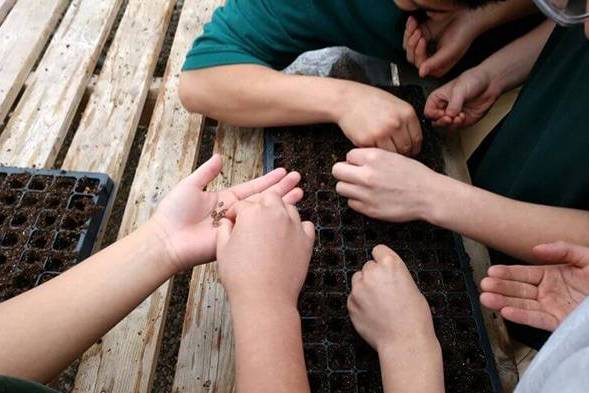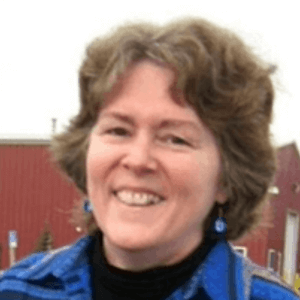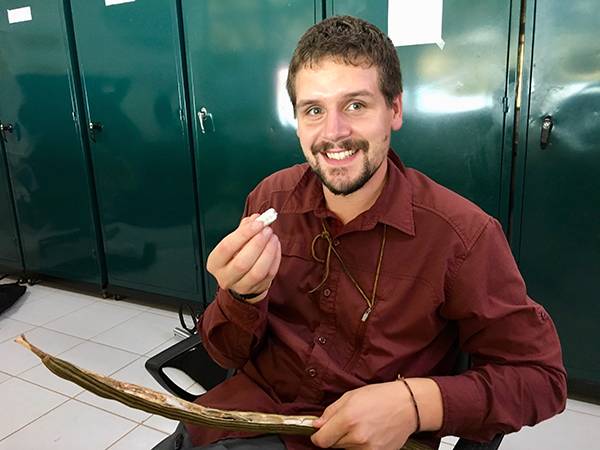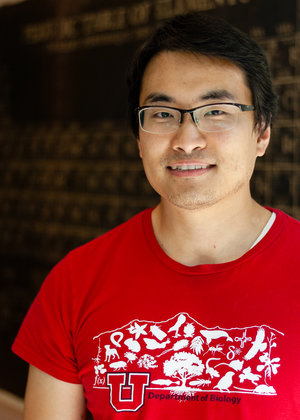Summer 2020 Newsletter

Letter From STEMAP Team
Dear STEM Ambassadors and Community Partners,
The STEM Ambassador Program has had a busy summer! Our Ambassadors shifted to remote engagement as the University closed, and have been participating in online meetings and remote activities with youth centers.
STEMAP presented at the virtual Ecological Society of America’s Annual Meeting in August, and collaborated with the STEM Community Alliance Program to bring a week of remote science activities to the Slate Canyon School in Provo, UT.
Ambassadors Emily Scott and Dale Forrister carried out online engagement activities. Emily spoke with youth in care about the importance of nature for our health and well-being, and Dale met with a local home brewer’s club to talk about plant compounds in beer.
Finally, Nadkarni Lab intern Cynthia Checketts met with STEMAP collaborator Sue Allen to discuss public engagement. Read on for the full interview!
We are grateful to the Ambassadors and community partners who have worked with us to continue providing science engagement.
Thank you,
Nalini Nadkarni, Director
Caitlin Weber, Program Manager
Megan Young, Program Coordinator
Cynthia Checketts, Intern
Update on the STEM Ambassador Program Response to COVID-19
In response to COVID-19, the STEM Ambassador Program has been operating remotely. Several Ambassadors from the 2020 cohort were able to engage in virtual settings. We are currently exploring strategies to offer a new online training to support scientists in carrying out remote engagement activities.
We will continue to monitor changes to the University’s guidelines and update our work accordingly. Visit https://coronavirus.utah.edu/ for the latest University of Utah guidelines.
Spring 2020 Ambassador Recognition
The unexpected closure of the University of Utah campus posed a unique challenge for the Spring 2020 STEMAP cohort. STEMAP appreciates the flexibility and perseverance of Ambassadors as they adjusted to such sudden changes. Many Ambassadors were even able to shift to online formats for engagement.
Public engagement continues to be important, and working to re-imagine the ways in which scientists can engage is a pressing issue now. The STEM Ambassador Program recognized the achievements of the 2020 cohort in a virtual celebration on July 17th. Thank you to all the Ambassadors for all the hard work!
Opportunity for Engagement: STEM Community Alliance Program
The STEM Community Alliance Program has been working to establish remote methods for engagement with youth facilities, and is looking for scientists to participate in science discussions and activities this fall.
Youth In Care facilities house post-conviction juveniles and provide in-facility schooling. These students typically do not have access to museums or other forms of informal science education.
No in-person visits will be permitted for the time being, but presenters will be able to lead students in a remote hands-on projects and presentations.
If you are interested in planning an an activity with STEMCAP, please email Laura George.
STEMAP at Ecological Society of America Annual Meeting

STEMAP Director Nalini Nadkarni and Program Manager Caitlin Weber were thrilled to collaborate with Emily Cloyd from the American Association for the Advancement of Science on a special session for the virtual Ecological Society of America (ESA) Annual Meeting. During the session, six scientists (including two STEMAP alumni!) shared their experiences in public engagement. Scientists discussed how they benefited from conversations with the public and shared strategies for effectively connecting with different audiences.
You can find session details here.
Researcher Spotlight
Program intern Cynthia Checketts spoke with Sue Allen, a member of the STEMAP research team, about public engagement. Read about their conversation below!
STEMAP Advisor Sue Allen

By Cynthia Checketts, Nadkarni Lab Intern
Before launching the STEM Ambassador Program, Dr. Nalini Nadkarni sought out experts in informal science learning. This connected her to Dr. Sue Allen, who had previously headed up the NSF program that funded the project. Nalini and STEMAP staff have been thrilled to have Sue as part of the team since the project’s inception in 2016. I met with Sue via Zoom to discuss her experiences with STEMAP and how she’s seen it evolve into the training it is today.
When thinking about public engagement with science, Sue refers to the American Association for the Advancement of Science, which defines public engagement as, “intentional, meaningful interactions that provide opportunities for mutual learning, between science and the public. Mutual learning refers not just to the acquisition of knowledge, but also to increased familiarity with a breadth of perspectives, frames, and worldviews.” Sue loves the way this definition emphasizes learning as reciprocal and multi-faceted, and she sees many parallels to her own world, studying out-of-school learning by learners of all ages and backgrounds. “In the end you can’t force someone to understand something,” she says, “so you have to find common ground for learners to build their own understandings on.
STEMAP focuses on creating eye-opening engagement experiences not only for audiences, but also for scientists. “It’s incredibly rewarding for the scientists”, Sue says, “because they get experience of sharing their enthusiasm and having others connect with it in all kinds of ways.” Science and scientists are often perceived as being separate or isolated from society. Giving scientists an opportunity to break that barrier through authentic connections creates a new community that encompasses scientists and citizens working together. “Sometimes [scientists] dismiss certain populations as not being science interested or science capable. When they work with these audiences, they realize that they’re, in a lot of ways, no different from anyone else that they’ve talked with.” Sue points out that “a pillar of STEMAP is the idea of ‘you don’t have to know it all.’ You’re positioning yourself as a co-investigator, rather than as someone who needs to know everything, represent everything, make no mistakes.”
Sue recognizes that such discourse is difficult to achieve. Not only is there complexity in working with groups that have unique needs and learning styles, but presenting in new, non-traditional venues can be daunting. “It can be quite scary for both parties,” Sue explains. “I think it’s scary for the learners because they are revealing, in their questions, what they don’t know. And that’s a courageous thing for anybody to do. But it’s also scary for the scientists, because they are giving up full control of the agenda and truly letting the group drive the conversation.” While this way of engaging may feel uncomfortable and new, it’s here that Sue has seen the most growth and found the most joy. She told me about how she wound up teaching physics to doctors-in-training while she was in graduate school, and found that for her, “the thrill of working with students and trying to understand each other’s perspectives was just so joyful. It was far more joyful than doing the physics.”
It’s not surprising then, that when asked what advice she’d offer scientists, Sue suggested focusing less on “your compulsion to tell your coherent story and make the points that you really want to make,” and more on building authentic connections with the audience. “What’s more important is that the audience feel engaged and go away with a memorable experience of having been part of a conversation. In fact, having some unresolved questions is a great stimulus for curiosity-driven learning well beyond the end of a single experience. ” The main objective is “for you to be truly responsive to your audience.” Sue also suggests experimenting with new formats and venues to get the community actively involved. STEMAP has worked over the years to provide focused trainings to help scientists find such opportunities.
Ambassador Reflections
The following article was written by STEM Ambassadors about their engagement experiences, which took place remotely due to COVID-19 closures. In-person programs are postponed until further notice.
Emily Scott with Decker Lake Youth Center

When Covid-19 hit, many people were forced to come up with creative, virtual solutions for their work, school, and outside activities. As an academic researcher and scientist, I was fortunate to have some of my work (e.g., analyzing data, writing papers to publish) be possible to do remotely.
While I had been planning on giving an in-person lecture to the Decker Lake Youth Center, it was a relatively easy transition to pre-recording the lecture over Zoom instead. This gave me additional time to prepare the lecture and find ways to make it interactive, since I couldn’t interact with a live audience.
I achieved this through having participants watch interactive experiment videos via YouTube during and after the lecture. This was pretty successful, and feedback showed that the participants liked the interactive videos. We followed up the lecture with a live Q & A about a week later (also over Zoom).
Unfortunately, I couldn’t hear the questions that participants were asking, which made it hard to have a discussion around the content, but it was great to be able to see their faces. What I’ve learned through this experience is that technology is a double-edged sword – it can provide greater accessibility while still mimicking an in-person experience (a definite advantage of all the virtual growth we are seeing in education settings), but you are also heavily dependent on that technology working.
I probably will always prefer to give lectures and teach in person, but I think as we move increasingly online there will be more of a demand to communicate virtually. It’s a different type of skill (one that I could definitely improve on), but there are a lot of great resources out there. I’m constantly impressed with the creative resources I find for online course content (e.g., games based on scientific concepts).
Participating in the STEM Ambassador Program has also inspired me to think bigger and more creatively about how to communicate my research, rather than traditional lecture formats. Thank you to the Decker Lake Youth Center for having me speak about my research and for allowing me to give my lecture virtually! It was great to have this opportunity, and I hope to only get better at giving virtual lectures in the future!
Dale Forrister

Graduate school like most things in life is a total balancing act. As students we have to learn how to juggle our research, our fieldwork, our teaching responsibilities, public engagement and writing papers, not to mention some work life balance and a social life. Taken together, I often feel like my entire life is planned out several months in advance with important dates like the start of field work and grant deadlines. Though I was excited by a chance to learn new skills and get connected with the Salt Lake Community, my experience in STEMAP, in some ways felt like another thing to juggle. So, when I first set out to plan an engagement activity with the Hop-Bombshells (https://hopbombshells.com/), a group of all female brewers and beer enthusiasts, I struggled to design an activity that worked within the bounds of my previous commitments and my focal groups meeting schedule. That is, until everyone’s world was turned upside down with the coming wave of COVID-19.
At first it felt so strange to watch as all my carefully planned out spring and summer plans quickly dematerialized and I was left with an entirely open schedule and lots of time at home. Like most of the world, I quickly realized that this change wasn’t all bad, as it also ushered in new opportunities and more time to reflect. Surprisingly, one of those opportunities was a chance to actually follow through on my STEMAP engagement plans with the Hop Bombshells. Just with a small caveat, that my engagement activity would not be in person.
I was lucky enough to have met with the Hop Bombshells on two separate occasions prior to COVID-19. The first was over beers at the groups monthly “Hoppy Hour” meeting where we were able to informally discuss what STEMAP was, and why I chose to work with them. I explained that I was interested in working with brewers because 1) I love beer and beer making and 2) that I study how plants defend themselves from being eaten by producing a cornucopia of chemical toxins, many of which humans have coopted for their food, material and medicines. I was able to explain how I think beer, and the brewing process, is one of the best examples of how plant natural products have become a central part of our lives and society and that most people don’t even realize where they come from in the first place.
For my second visit, I joined the Hop Bombshell ladies at Salt Fire brewing (https://www.saltfirebrewing.com/) where the group collaborated with Salt Fire’s head brewer in order to brew a Rye IPA that would be on top in time for the “Pink Boots” tap take-over in honor of International Woman’s month. This was a really fun opportunity to meet lots of people from the group and to learn more about beer making. If you’ve ever brewed you know there is a lot of downtime between steps, and that downtime left room for beer tasting and informal discussions about all sorts of topics ranging from beer, work, living in Utah, my research and just life in general. I was also able to take advantage of this brew day by taking samples throughout the brew process that I could analyze in our lab in order to determine which chemical compounds were found in the beer and hops they were using.
Fast forward two months of quarantine, the date of my “actual” engagement activity was here and I began to present from an unlikely location, my living room – surrounded by a forest of rescued office plants, two tanks of fish that also rescued from the university and 5 baby COVID chickens, we had decided to raise during quarantine. Though I had met the group before, it was quite intimidating talking over zoom. I had never given a digital talk before and I felt that it was really hard to come up with creative ways of engaging with my group besides defaulting to the classic power point presentation. In the end it worked out and we were able to foster some fun discussion starting with everyone going around and sharing what beers they were drinking and why they liked or disliked them. My goal for the presentation was to find the commonalities between beer brewing and my research on plant chemistry. I shared photos and videos showing what I do and I walked them through the data I collected on their beer samples. Given the format, I was happy with the outcome and really excited that people asked me questions about my research and participated as I asked them questions about the brewing process and the ways in which they utilize plant compounds in the beers they brew. In the end, I’d probably rather have done the event in person but I was proud that we all were able to be flexible and to challenge myself to find a way to engage with the Hop Bombshells despite everything happening around us. Thanks to the STEMAP team for helping me adapt, and to all the ladies in the Hop Bombshells for welcoming me into the group.
Danny Bae at Farmington Bay Youth Center

Despite my initial engagement plan being cancelled due to COVID-19, I, thankfully, had an opportunity to present my research to youth in custody this summer via ZOOM. The topic of the presentation was neurodegeneration and my own research. I’ve always been passionate about inspiring others to think more about science, and this opportunity provided me with a great venue to do just that. As a scientist constantly interacting with other scientists, it has been a challenge to explain difficult concept without jargons.
During the preparation, I had a difficult time adjusting my slides for a younger audience. Fortunately, with the help from STEMAP and STEMCAP staff, I was able to describe and explain the relationship between cells and organs/organisms using a Lego analogy. I was not able to see the reactions of the students during my online presentation; however, the questions I received at the end gave me confidence that the students were engaged.
After the activity, I was pleased to receive an email with positive feedback from one of the teachers at the facility. This was truly a rewarding experience. I believe this type of engagement benefits both scientists and the public. Some scientists believe inspiration can only come from interacting with other experts and scientists, however, I always learn something new by interacting with people both in and outside my field. Questions and comments from such interactions often open my eyes and help me think outside the box. In closing, I sincerely thank the students and the teachers for giving me an opportunity to present my research, and STEMAP and STEMCAP for coordinating all this during this difficult time of COVID-19. I hope to continue this interaction in the future!
About the Blog
Discussion channel for insightful chat about our events, news, and activities.
Categories
Featured Posts
Tag Cloud
- UoG (2)
- Guam (2)
- ethnobotany (1)
- environmental policy (1)
- student immersion (1)
- engineering (1)
- Virgin Islands (1)
- USVI (2)
- lionfish (1)
- children's home (1)
- conservation (1)
- marine ecology (1)
- youth (1)
- sustainability (2)
- Utah (1)
- Arizona (1)
- Nevada (1)
- southwest (1)
- virtual (1)
- project management (1)
- training (1)
- naturalist (1)
- forest (1)
- ecosystem (1)
- Puerto Rico (1)
- Spanish (1)
- library (1)
- Huntington's (1)
- medical science (1)
- Emmanuel Ngwoke (1)
